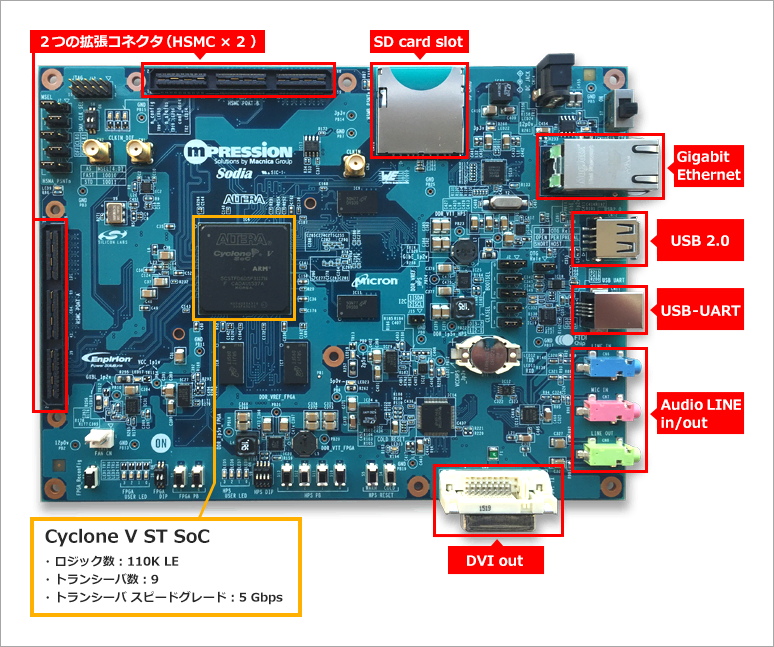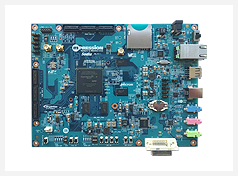Commitment to 2 HSMC and video output DVI
What can Altera SoCs be used for? How can customers benefit from using it?
Customers using Helio said, "I want to directly output the data processed by SoC / FPGA to the monitor", and "I want to control the motor using FPGA logic and Dual Core ARM at the same time." We received various requests such as Therefore, this time, we have developed a baseboard that can realize what the customer wants to do by installing two HSMC (High Speed Mezzanine Card) connectors onboard for video output and providing expandability.
It will be a product that is positioned differently from the development kits released by Mpression Helio and Terasic.

High-end model of Helio
It is an evaluation board equipped with Altera's Cyclone V ST SoC, and was developed as a high-end model of the Mpression brand "Helio".
The biggest feature of Sodia is that it is possible to evaluate and develop various functions with this one unit. Compared to Helio, the size of the FPGA is larger, and not only memory and expansion connectors but also audio and video output are added, making it a specification that meets the needs of more customers.
| Dev kit | Sodia | Helio | Terasic Atlas-SoC |
| Devices | 5CSTFD6D5F31I7N | 5CSXFC5C6U23C7N | 5CSEMA4U23C6N |
| Logic Element | 110K | 85K | 40K |
| HPS DRAM | 1GB DDR3-800 (w/ECC) | 1GB DDR3-800 | 1GB DDR3-800 |
| FPGA DRAM | 256MB DDR3-600 | - | - |
| Flash | 512Mb QSPI Flash, EPCQ256, EEPROM | EPCQ256, EEPROM | EPCS128 |
| USB | USB2.0 Host x1 | USB2.0 OTG x1 | USB2.0 OTG x1 |
| Ethernet | 10/100/1000 Ethernet | 10/100/100 Ethernet | 10/100/100 Ethernet |
| UARTs | UART to USB | UART to USB | UART to USB |
| Transceiver | 5Gbps x6 | - | - |
| Video out | DVI | - | - |
| Audio | Mic IN / LINE IN / LINE OUT | - | - |
| FPGA Expansion | HSMC x2 | HSMC x1 | Arduino, 2x20pin header x2 |
| LED PushSW DIPSW |
x6 LEDs x6 Push SW x6 DIPSW |
x4 LEDs x4 Push SW x4 DIPSW |
X8 LEDs X2 Push SW X4 DIPSW |
| JTAG | External USB blaster | On-board USB blaster II | On-board USB blaster II |
| Other I/F | RTCs | RTC, 16x2 Character LCD | 2x7 Header |
Sodia
The SDI camera input is input to Sodia, the video in the SD card is decoded by the Cyclone V ST SoC, and both videos are combined on the screen and output to DVI. Together, Linux runs on the Cyclone V ST SoC and Xwindow runs on the LVDS panel. Animated images are output to DVI under Xwindow control (using keyboard and mouse).
Below is a configuration example based on the demonstration conducted at ET2015. Please use all means.

Click here for recommended articles/materials
- Acceleration of SoC FPGA using OpenCL - Application example of Sodia -
- Demonstration using video conversion and OpenCL - Sodia usage example -
Introducing 3 types of demos using video conversion and OpenCL using Mpression Sodia board - Run Linux on Altera Cyclone V ST SoC and display it on a small LCD -Usage example of Sodia-
- Cyclone V ST SoC platform "Sodia" composites and outputs camera video and video on a 1024x768 (XGA) screen
- This part of "Sodia" is amazing! ~Developer's Passion~ Ensuring stability of operation and diversion to board development as it is
Sodia is more than just specs! That is the "customer's perspective" that Sodia developers valued - Software compatible, but what is the difference between Sodia and Helio?
- RocketBoards.org
Reference manual, Getting Started, board schematics, board bill of materials, board layout diagrams, Linux and FPGA reference designs, and demo designs are available on the RocketBoards site.


